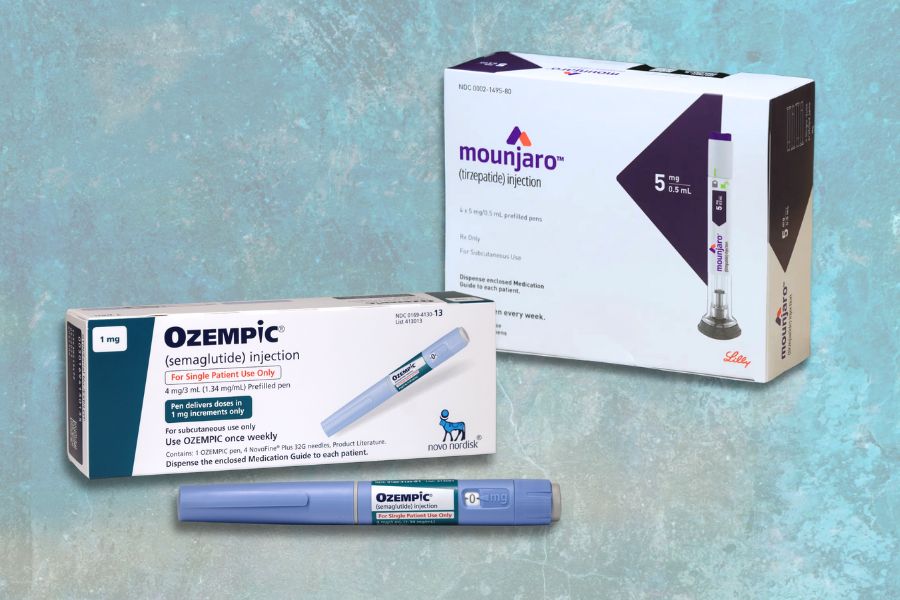Ozempic vs. Mounjaro: Exploring the Weight Loss Option

*Disclaimer: The following information provided is intended for general informational purposes only. It should not be considered as medical advice or a substitute for professional medical consultation.
According to UC Health, more than 70 percent of Americans are either considered overweight or obese, so it only makes sense that people are turning to anything they can find to help them try to lose weight and improve their health. One trend that has become popular in recent months is taking drugs designed for people with type 2 diabetes.
Drugs like Ozempic and Mounjaro promise to help you lose pounds, lower your blood sugar, and have a positive impact on your hemoglobin A1C or HbA1c test. But which one works the best for all of these issues? Well, you should always consult with your doctor before taking any kind of medication, but let’s look at the similarities and differences between these two drugs.
(Image via Unsplash)
What Is Ozempic?
Ozempic is a prescription medication that claims to “lower blood sugar in adults with type 2 diabetes along with diet and exercise.” It’s a brand name of the generic drug semaglutide, which is a glucagon-like peptide-1 (GLP-1) receptor agonist, and it’s part of the incretin mimetics drug class. Ozempic has been approved by the United States Food and Drug Administration (FDA) for the treatment of type 2 diabetes as well as cardiovascular health, particularly in adults with type 2 diabetes and cardiovascular disease. It’s also sometimes prescribed as a weight loss drug to prevent adults from developing cardiovascular disease and hypertension.
What Is Mounjaro?
Mounjaro is similar to Ozempic in that it’s a GLP-1 receptor in the incretin mimetics drug class that is also used to treat adults with type 2 diabetes. Made by Eli Lilly, it is also a glucose-dependent insulinotropic polypeptide (GIP), which is the main difference between the two drugs. Essentially, this means it mimics two hormones usually found in your body compared to the one that Ozempic mimics. Mounjaro is a brand name for the generic drug tirzepatide, and it’s also been approved for people with type 2 diabetes in the U.S. It’s currently being researched as a potential weight loss drug.
How Does Each Drug Affect Weight Loss?
While both drugs were designed for adults with type 2 diabetes, both have been associated with weight loss as well. Ozempic is approved for weight loss while Mounjaro is awaiting approval. Keep in mind that you need a prescription from your doctor to access both medications.
Ozempic works by slowing down how fast foods move through your digestive system, which leaves you feeling fuller for longer periods of time and can prevent you from overeating. Mounjaro works similarly in that it helps you feel full and slows down your digestion rate.
However, studies have shown that people who take Mounjaro lose more weight compared to those who take Ozempic. According to GoodRx Health, in one particular study, people who took Mounjaro lost 16 to 25 pounds on average, while those who took Ozempic lost about 12 pounds. When receiving the highest dose of each medication, one in three people lost 15 percent of their body weight while taking Mounjaro, and one in 10 people lost 15 percent of their body weight while taking Ozempic.
How Does Each Drug Affect Blood Sugar and A1C?
Both Ozempic and Mounjaro were created as drugs for adults with type 2 diabetes. Both claim to lower blood sugar and decrease your A1C over time.
According to Mounjaro, up to 90 percent of people who took the drug in a trial, reached an A1C of less than 7 percent while taking 10 milligrams of the drug. Mounjaro works by stimulating hormones that control blood sugar and suppressing your appetite.
Ozempic works by stimulating the pancreas to produce more insulin and preventing the liver from producing too much sugar. According to the company, a 40-week study showed that adults with an average starting A1C of 8.2 percent saw a 1.6 percent increase while taking 1 mg of the drug. Overall, studies have shown that Mounjaro works better at lowering your A1C.
 What are the Side Effects of Each Drug?
What are the Side Effects of Each Drug?
While Mounjaro offers better results when it comes to weight loss and lowering your A1C, Ozempic tends to have less dangerous side effects. However, both drugs come with their fair share of side effects and should only be taken with caution under a doctor’s order.
The most common side effects of Mounjaro impact your gastrointestinal system. They include issues that include nausea, vomiting, diarrhea, burping, indigestion, constipation, and gastroesophageal reflux disease (GERD). In some trials, these symptoms were severe, although they tend to occur in people who take a higher dose. An increase in heart rate, problems with the injection site, and increased levels of pancreatic enzymes are also common. More serious side effects include acute kidney injury, vision changes, gallbladder issues, and low blood sugar. The most serious potential side effects of the drug are thyroid cancer and inflammation of the pancreas. In studies completed on animals, some who took the drug developed a tumor on their thyroids.
Ozempic’s side effects are similar. The most likely symptoms you’ll experience while taking the drug are gastrointestinal, like nausea, diarrhea, indigestion, burping, gas, and stomach pain. You may also experience eye symptoms, such as diabetic retinopathy, injection site reactions, low blood sugar, and other metabolic issues. More serious side effects can include thyroid tumors, swelling of the face ― which is usually just cosmetic and not dangerous ― acute kidney injury, gallstones, pancreatitis, and fainting.
How Do You Take Each Drug?
Both drugs are taken via injection. You receive a single-dose pen and take a dose once a week. You choose a time and day of the week and take it on schedule. Choose an injection site on the stomach, back of the upper arm, or thigh. You can do the injection yourself or have a friend or family member do it.
The recommended starting dose for Mounjaro is 2.5 mg and 0.25 mg for Ozempic. Eventually, you may need to work up to a higher dose. The maximum dose for Mounjaro is 15 mg, while the maximum dose for Ozempic is 2 mg.
Keep in mind that the two drugs are not interchangeable. You can switch from one to the other if you want to, but you should always do so under a doctor’s care.






